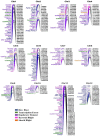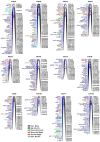Prospects of Understanding the Molecular Biology of Disease Resistance in Rice
- PMID: 29642631
- PMCID: PMC5979409
- DOI: 10.3390/ijms19041141
Prospects of Understanding the Molecular Biology of Disease Resistance in Rice
Abstract
Rice is one of the important crops grown worldwide and is considered as an important crop for global food security. Rice is being affected by various fungal, bacterial and viral diseases resulting in huge yield losses every year. Deployment of resistance genes in various crops is one of the important methods of disease management. However, identification, cloning and characterization of disease resistance genes is a very tedious effort. To increase the life span of resistant cultivars, it is important to understand the molecular basis of plant host-pathogen interaction. With the advancement in rice genetics and genomics, several rice varieties resistant to fungal, bacterial and viral pathogens have been developed. However, resistance response of these varieties break down very frequently because of the emergence of more virulent races of the pathogen in nature. To increase the durability of resistance genes under field conditions, understanding the mechanismof resistance response and its molecular basis should be well understood. Some emerging concepts like interspecies transfer of pattern recognition receptors (PRRs) and transgenerational plant immunitycan be employed to develop sustainable broad spectrum resistant varieties of rice.
Keywords: biotic stress; breeding; disease resistance; marker assisted selection; rice; signaling pathways; transcription factor.
Conflict of interest statement
The authors declare no conflict of interest.
Figures




References
-
- Sharma T.R., Rai A.K., Gupta S.K., Vijayan J., Devanna B.N., Ray S. Rice blast management through host-plant resistance, retrospect and prospects. Agric. Res. 2012;1:37–52. doi: 10.1007/s40003-011-0003-5. - DOI
-
- Ou S.H. Rice Diseases. 2nd ed. Commonwealth Mycological Institute; Kew, UK: 1985. pp. 61–96.
Publication types
MeSH terms
LinkOut - more resources
Full Text Sources
Other Literature Sources

